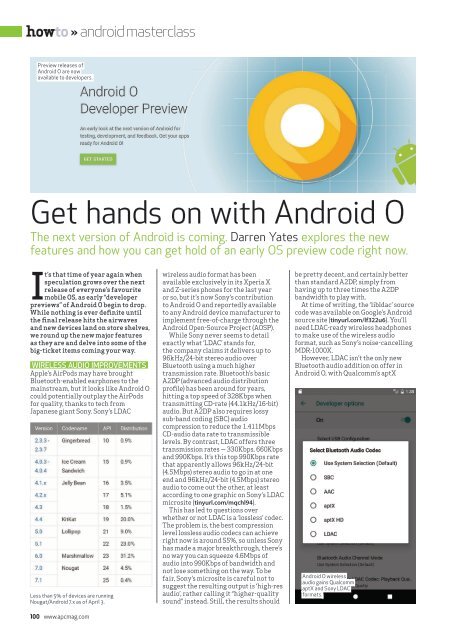You also want an ePaper? Increase the reach of your titles
YUMPU automatically turns print PDFs into web optimized ePapers that Google loves.
howto » android masterclass<br />
Preview releases of<br />
Android O are now<br />
available to developers.<br />
Get hands on with Android O<br />
The next version of Android is coming. Darren Yates explores the new<br />
features and how you can get hold of an early OS preview code right now.<br />
It’s that time of year again when<br />
speculation grows over the next<br />
release of everyone’s favourite<br />
mobile OS, as early “developer<br />
previews” of Android O begin to drop.<br />
While nothing is ever definite until<br />
the final release hits the airwaves<br />
and new devices land on store shelves,<br />
we round up the new major features<br />
as they are and delve into some of the<br />
big-ticket items coming your way.<br />
WIRELESS AUDIO IMPROVEMENTS<br />
Apple’s AirPods may have brought<br />
Bluetooth-enabled earphones to the<br />
mainstream, but it looks like Android O<br />
could potentially outplay the AirPods<br />
for quality, thanks to tech from<br />
Japanese giant Sony. Sony’s LDAC<br />
Less than 5% of devices are running<br />
Nougat/Android 7.x as of April 3.<br />
100 www.apcmag.com<br />
wireless audio format has been<br />
available exclusively in its Xperia X<br />
and Z-series phones for the last year<br />
or so, but it’s now Sony’s contribution<br />
to Android O and reportedly available<br />
to any Android device manufacturer to<br />
implement free-of-charge through the<br />
Android Open-Source Project (AOSP).<br />
While Sony never seems to detail<br />
exactly what ‘LDAC’ stands for,<br />
the company claims it delivers up to<br />
96kHz/24-bit stereo audio over<br />
Bluetooth using a much higher<br />
transmission rate. Bluetooth’s basic<br />
A2DP (advanced audio distribution<br />
profile) has been around for years,<br />
hitting a top speed of 328Kbps when<br />
transmitting CD-rate (44.1kHz/16-bit)<br />
audio. But A2DP also requires lossy<br />
sub-band coding (SBC) audio<br />
compression to reduce the 1.411Mbps<br />
CD-audio data rate to transmissible<br />
levels. By contrast, LDAC offers three<br />
transmission rates — 330Kbps, 660Kbps<br />
and 990Kbps. It’s this top 990Kbps rate<br />
that apparently allows 96kHz/24-bit<br />
(4.5Mbps) stereo audio to go in at one<br />
end and 96kHz/24-bit (4.5Mbps) stereo<br />
audio to come out the other, at least<br />
according to one graphic on Sony’s LDAC<br />
microsite (tinyurl.com/mqchl94).<br />
This has led to questions over<br />
whether or not LDAC is a ‘lossless’ codec.<br />
The problem is, the best compression<br />
level lossless audio codecs can achieve<br />
right now is around 55%, so unless Sony<br />
has made a major breakthrough, there’s<br />
no way you can squeeze 4.6Mbps of<br />
audio into 990Kbps of bandwidth and<br />
not lose something on the way. To be<br />
fair, Sony’s microsite is careful not to<br />
suggest the resulting output is ‘high-res<br />
audio’, rather calling it “higher-quality<br />
sound” instead. Still, the results should<br />
be pretty decent, and certainly better<br />
than standard A2DP, simply from<br />
having up to three times the A2DP<br />
bandwidth to play with.<br />
At time of writing, the ‘libldac’ source<br />
code was available on Google’s Android<br />
source site (tinyurl.com/lf322u6). You’ll<br />
need LDAC-ready wireless headphones<br />
to make use of the wireless audio<br />
format, such as Sony’s noise-cancelling<br />
MDR-1000X.<br />
However, LDAC isn’t the only new<br />
Bluetooth audio addition on offer in<br />
Android O, with Qualcomm’s aptX<br />
Android O wireless<br />
audio gains Qualcomm<br />
aptX and Sony LDAC<br />
formats.


















